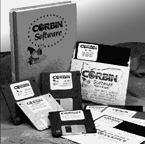
 Bullet Swaging Software : For the custom bullet maker.
Bullet Swaging Software : For the custom bullet maker. Corbin Simplified Payroll : The top certified payroll for Oregon employers!
Corbin Simplified Payroll : The top certified payroll for Oregon employers! Corbin Time Clock : Automatic job time recorder (integrates with payroll).
Corbin Time Clock : Automatic job time recorder (integrates with payroll). Corbin Maillist Manager: Mailing list enter, merge, sort, print and more...
Corbin Maillist Manager: Mailing list enter, merge, sort, print and more... Powder Coating Data System: Complete software for powder coat job shop...
Powder Coating Data System: Complete software for powder coat job shop... Cedar Billing System: A remarkably easy client billing and receivables system...
Cedar Billing System: A remarkably easy client billing and receivables system... Production Tracking System: Keep track of what was produced, for whom, when...
Production Tracking System: Keep track of what was produced, for whom, when... The Namer Program: Find the perfect name for anything!
The Namer Program: Find the perfect name for anything! Installation and Updates : How to install or update ANY Corbin title.
Installation and Updates : How to install or update ANY Corbin title. Visually Impaired Clients : Special features for text/speech conversion.
Visually Impaired Clients : Special features for text/speech conversion. Ordering Information : Where to order or contact us for further information.
Ordering Information : Where to order or contact us for further information. Price List : Software and programming services.
Price List : Software and programming services.
Installation and Updating Corbin TitlesIt's easy to install or update any Corbin software in MS-DOS or Windows: |
 For the Blind or Visually Impaired User
|
Corbin Simplified MaillistMS-DOS, 1 floppy disk |
 Cedar Billing systemMS-DOS, 1 floppy disk |
 Powder Coating Data SystemMS-DOS, 1 floppy disk |
ShopWorkShopwork is a production tracking program that is designed to be used by large or small manufacturers, including home businesses. It keeps track of what you made, who you made it for (whether for stock or for a custom order, for instance), details of what was different on custom jobs, when you made it, how much it cost, and other details that you might need to know even years later. |
 The Namer ProgramCorbin's NAMER is one of those strange but useful tools that you don't use very often, but when you need it, it pays to have one around! NAMER suggests a virtually unlimited number of names for products, firms, or anything else that you want to name. The way it works is that you enter a series of random name fragments (and there are a number of them already in the database) that you more or less like but can't seem to put together into a suitable snappy name. You code the words or phrases as to whether they will always be a prefix, middle, or suffix in the phrases or names to be suggested, or whether they can float to any position. |
Start writing here...

About Corbin Software